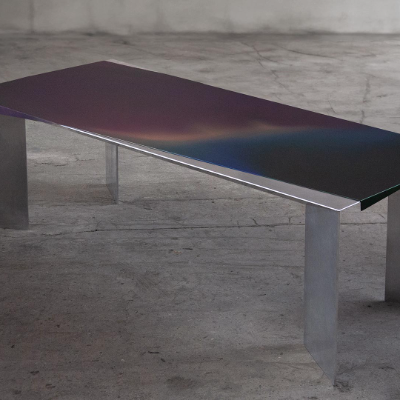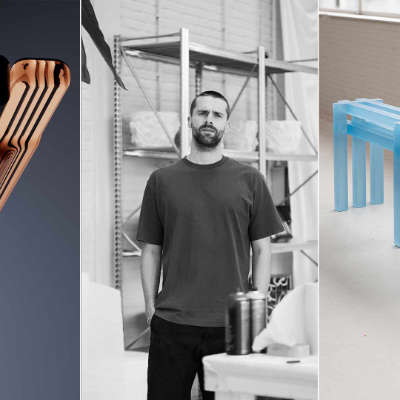Abracadabra, a word found in some of our favourite childhood novels. Abracadabra, a spell associated with a healing touch. Abracadabra, a term that, when traced across history, dates back to the third century CE, and signifies both creation as well as the warding off of evil spirits and forces to create an ambient environment, is also the name of a recently concluded exhibition that was showcased in Milan, Italy, during Milan Design Week 2023. The Abrakadabra exhibition, conceptualised by Italian glassmakers WonderGlass, on the occasion of the 61st edition of Salone del Mobile, occupied Istituto dei Ciechi, a 19th-century structure, and presented experiments in glass by renowned international designers. Each creator’s piece at the exhibition, in staying true to the title and thematic of the exhibition, exudes an ethereal charm, almost as if a wish to a fantastical world has been granted. They serve as portals to imagined lands. The transparent feature of glass tends to this assertion, and enhances it. The pieces on display at once appear sturdy enough for regular usage and dreamy enough to occupy parallel lands that exist in our minds.
On view from April 18 to 23, 2023, the group exhibition, realised under the artistic direction of Jean Blanchaert, platformed the works of Paul Cocksedge, Tom Dixon, Elisa Ossino, John Pawson, Elena Salmistraro, studiopluz, Bethan Laura Wood, and Dan Yeffet. “This exhibition not only explores the vitreous material in visual culture but also celebrates it as the DNA of WonderGlass: the expert techniques animating their furnaces and workshops in the Venetian region,” shares Jean Blanchaert.
The Abrakadabra exhibition serves as a tribute to the magic of glass and the limit it can be stretched to. Regarding the Fuorisalone exhibition, Christian Mussati, Founder of WonderGlass shares, “We believe in the vibrant conversation between art and design; we are inspired by the idea of finding that ever-evolving fascination given by the mix of innovation, craftsmanship and wonder. For this 61st edition of Salone del Mobile, we have decided to reveal what normally lies behind: tangibly making real the three main glass processing techniques in a bold and innovative way. “Glass will be conceived and presented to its fullest potential in all its manifestations, from art to design, from architecture to fashion. The aim is always to activate new and organic synergies, revealing the magic that can be generated when creativity and craftsmanship combine with imagination.”
STIR shines a light on the eight creatives whose works were displayed at the group exhibition, as well as the corresponding objects created by them. From contemporaneous visages to artisanally rich patterns, and sculptural forms to archaic references, the eight glassworks at the exhibition not only radiated with their own charm but also lit up the space and the pieces displayed alongside them.
Wonder by Paul Cocksedge
British designer Paul Cocksedge’s Wonder is an illuminated triptych installation defined by simple circular compositions which are coloured in subtle hues and tones. The translucent droplets are shaped by scooping out liquid glass from the furnace and pouring it to condense them into their final forms. These droplets, when hung behind rectangular windows, appear like blobs of wondrous objects floating mid-air. The crossfade of colours, from one hue to the other, helps create a miscellany of organic forms and colours that fill the space with an aura of calmness. The alchemy of light, colours, and cast glass projects an effect atypical of glassworks.
Venetia by Elisa Ossino
Elisa Ossino is an Italian designer and architect whose work is a combination of geometric abstractions, monochromatic patterns and metaphysical references. Venetia, too, is a combination of straight lines, washed-down colours, and monochromatic abstractions. Made using Murano glass tiles that are assembled by fusing, perforating and bounding the individual elements using transparent threads, Venetia, whose colours are inspired by the hues of lagoons, and from the Italian city of Venice, make for remarkable partitions—linear, curved or cylindrical in form—that serve as room separators that let the light flow in.
Taliso Coffee Table by Elena Salmistraro
The Taliso Coffee Table, by Italian product designer and artist Elena Salmistraro, is a kaliedoscopic and multi-leveled furniture, made using cast-glass sheets of various shapes and sizes. The geometric table, complex in its form, is inspired by architectural principles that facilitate the placement of non-identical elements in a balanced composition. While the overall form of the table is minimalistic, delicate and alludes to contemporary forms, the surface of the table is characterised by raw and primitive textures.
Kimera by studiopluz
London-based studiopluz, under the helm of Simone Zecubi, operates as a multidisciplinary studio creating objects at the intersection of art and design. Their design for the Abrakadabra exhibition, Kimera, is a lamp shaped like a wheel. A fusion of various materials and techniques, Kimera is designed as an object that encompasses the attributes of mythological creatures—made up of contrasting animal parts. Created as an object that symbolises evolution and the transient state of being, the lamp is designed in a manner such that it seems to be in flux, never constant.
Bouchon by Dan Yeffet
Paris-based designer Dan Yeffet’s Bouchon is a collection of blue side tables that, despite being made out of handmade blown glass, embody a metallic lustre. The forms of all the pieces are inspired by the shapes of bottle caps. Each piece is sturdy enough to stand independently. Yet, the tables appear light.
Chain Side Table by Bethan Laura Wood
English designer Bethan Laura Wood’s creations are attributed by an atypical vibrancy and visually rich patterns. The Chain Side Table by Wood alludes to this defining aesthetic. Made up by stacking multiple donut bricks sliced into two halves and connected to each other through the centre, the final design resembles the insides of an intricately designed machine. The delicate yellow tone of the table support shines out through the transparent glass top. The curved ends, polished and detailed to resemble the compositions of archaic Japanese wooden temples, help ascribe familiarity and an old-world charm to the otherwise contemporary creation.
Berg by John Pawson
John Pawson, a designer and architect from the United Kingdom, builds objects and furniture in fairly simple silhouettes. The Berg Coffee Table and Berg Side Table by Pawson, too, are fairly simple forms, sculpted in glass. In utilising rectilinear lines and thick elements to build the table, Pawson succeeds in creating a piece where the material of the object is enhanced and prominent.
Slump by Tom Dixon
Slump is a table lamp whose form evinces the state of being from which its name is inspired. Tom Dixon designed the mould for this lamp in a manner that would enable its liquid constituents to easily bend into a curve. This shape is not only aesthetic in its own right but also orients the light rays to fall on the front tip of the lamp, creating hence a bright spot at its topmost point.
STIR’s coverage of Milan Design Week 2023 showcases the best exhibitions, studios, designers, installations, brands, and special projects to look out for. Explore Euroluce 2023 and all the design districts—5Vie Art and Design, Brera Design District, Fuorisalone, Isola Design District, Tortona District, and Milano Design District—with us.






 Sign in with email
Sign in with email








What do you think?